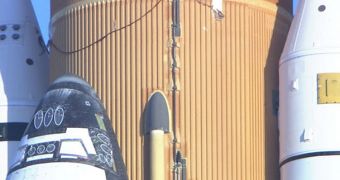Following more than six weeks of delays from its originally-planned launch date, the shuttle Discovery is currently undergoing a large battery of tests. Engineers at NASA want to ensure that everything is in order for the February lift-off, and also that the root cause of the past glitches is discovered.
While at the Launch Pad 39A facility following a late September rollout, engineers checking the orbiter discovered a series of damage marks on the spacecraft massive external fuel tank (EFT).
Upon further inspection, they discovered numerous such marks, and were forced to postpone the launch to early December. However, those dates did not materialize either, largely because not all glitches had been properly repaired.
The American space agency unfortunately has a sad history with losing crews over improper safety measures. Astronauts aboard the shuttles Challenger and Columbia were victims of lax safety measures, so NASA was not about to send Discovery into space in its condition.
Still, fixing the EFT proved a little more difficult than first thought. This is largely due to the fact that the damage is extensive, but also because the New Orleans-based Michoud Assembly Facility has ceased operations.
According to experts, it would take at least two more years for a new EFT to be produced. As such, engineering teams have only two options – either make do with what they have, or propose the cancellation of the STS-133 mission.
Yesterday, December 17, the teams were confident enough in their repair work to allow for a tanking test to be conducted. As such, millions of gallons of propellant were loaded into the EFT.
The super-cold chemicals will give ground teams an idea on whether the cracks in the EFT walls are still there, or whether all of them have been taken care of.
The tanking test started at 7 am EST (1200 GMT) and ended at 2:25 pm EST (1925 GMT). At this point, experts are waiting for the tank to be emptied, and then for it to heat up to ambient temperatures.
A large array of sensors mounted on the tank are collecting data around the clock. “It looks like we're getting good data,” explained NASA official Mike Moses, quoted by Space.
“Like anything with a hazardous operation, it is nice and boring today, which is a good thing. Everything is looking like it is supposed to,” he goes on to say.
Moses holds an appointment as the space shuttle launch integration manager at the NASA Kennedy Space Center (KSC), in Cape Canaveral, Florida. At this point, he added, Discovery is due to launch no earlier than February 3.
“The point of the [test] is to gather performance data on the tank. We have stringers instrumented in the repair area so we can look and see how the repair performs under a cryo load,” he explained.
“We have stringers instrumented next to that repair that aren't damaged, so we can see how they perform... and then on the opposite side of the tank, we've instrumented stringers to kind of go to a control-type theory, to say over here in a completely different area, here's how the tank performs,” Moses concluded.

 14 DAY TRIAL //
14 DAY TRIAL //